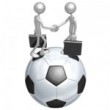Whether you call it soccer or football, the sport is the largest in the world and growing in popularity in the U.S. as well. Men’s Major League Soccer has expanded to 27 teams across the U.S. and Canada. So when you’re looking at selling branded items associated with your business, there’s no better place to look than how soccer teams manage selling their gear.
Corporations Are Customers
Don’t let your sales management team focus only on end-consumers of products. Soccer leagues and individual teams have proven the value of corporate sponsorships. Adidas pays Manchester United £75 million (over $100 million USD), each year to provide their licensed uniforms and all the gear sold to the public. That’s not even the largest deal in the Premier League; that honor goes to Liverpool and their deal with Nike for £80 million a year. Big money like this allows the teams to attract players they otherwise would not be able to afford.
It’s a far cry from the days when teams paid for uniforms. Both the team and the sports gear manufacturer have learned the cachet that a team name holds, and it’s worth more than a Nike Swoosh or Adidas stripe on its own. If you’ve invested in branding and have a strong market image, don’t underestimate its value. Premier League teams learned that their appeal is worth a lot to sports gear firms and have leveraged that into a new income stream.
Provide Variety
On the consumer side of the equation, teams have learned that you have to sell more than just a jersey with a popular team player number on it. When you have a wide variety of options and different price points, you’ll be able to pull in more customers and for the superfans, you’ll generate more sales because they’ll buy one of everything. Here are four sectors your business should consider when developing themed merchandising:
- For game day: bleacher cushions, blankets, umbrellas or sunbrellas
- Team gear: shirts, full uniforms, hats
- Tchotchkes: bumper stickers, koozies, license plate holders
- Superfan gear: fancy shirts, kids and baby clothes, customizable gear, signed original gear.
This last option, signed original gear, is a growing market. Teams have realized that fans love to have a piece of something special. Gear that’s been used by a member of the team has a glow to it that buying a mass-marketed reproduction will never match. Fans are willing to pay accordingly.
Use Technology To Reach Your Market
Finally, teams embrace technology to reach their customers. They no longer wait for their target audience to approach them at games or events; they use email and social media marketing to let fans know about their newest offerings. Waiting for game day means fans have already spent money on tickets and there are several pulls on available cash; customers have to decide on new gear, drinks or food. When the team can reach them at home with targeted marketing, all those other worries fall away and the customers only have to decide what size of the new training hoodie they need.
Sweeten the Deal
Teams have broken the code on abandoned carts too. Up to three-quarters of all online shopping carts are abandoned before checkout is completed and customers overwhelmingly say that it’s because add-ons like tax and shipping push the price out of their range. While no one can do much about taxes, teams have learned to keep a low free-shipping threshold and offer that free shipping worldwide. The internet has shrunk the world and you never know where your next fan is coming from, so limiting where you ship is throwing away customers.
Of course, teams like Manchester United have new fan gear several times a year, including updated color combos, patterns and items, including shirts that are for “pre-match” and annually updated kits so fans can match their favorite players each season.
While not every sales tactic will apply to your own business, you can see that thinking outside the box, diversifying offerings and diversifying revenue streams is something from which every business can benefit.







[…] Source link […]